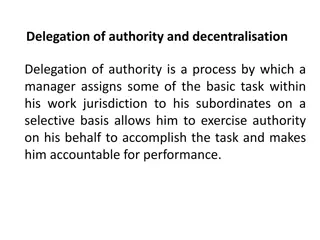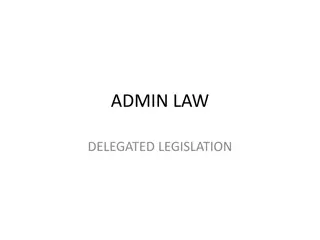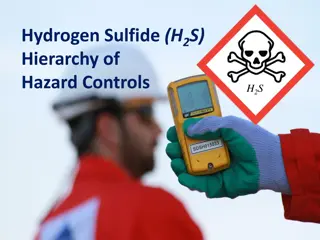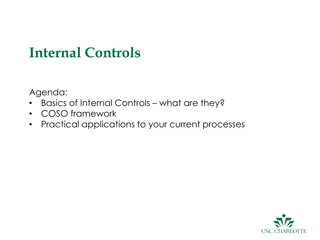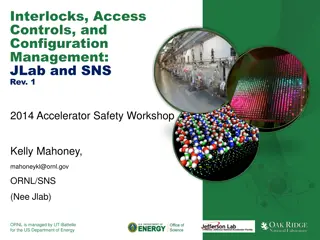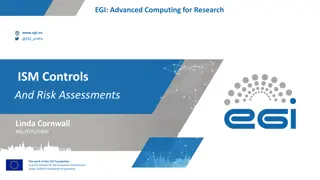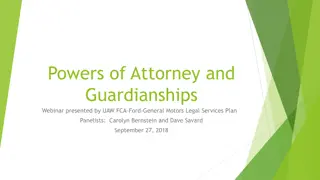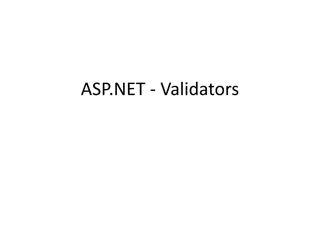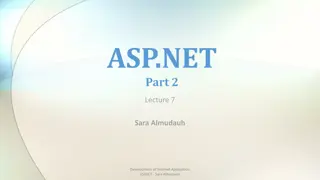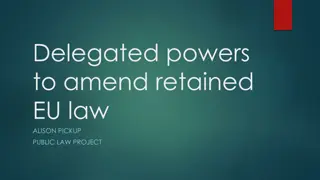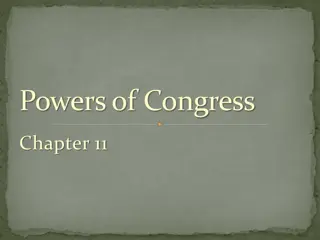Delegated Legislation: Powers, Controls, and Mechanisms
Explore the concept of delegated legislation, how powers are delegated, the need for checks and controls, mechanisms for oversight, and effectiveness in preventing misuse. Learn about Public General Bills, Private Bills, Green/White Papers, and the stages from Bill to Law. Understand the significance of Parent/Enabling Acts and why Delegated Legislation is utilized.
Download Presentation

Please find below an Image/Link to download the presentation.
The content on the website is provided AS IS for your information and personal use only. It may not be sold, licensed, or shared on other websites without obtaining consent from the author.If you encounter any issues during the download, it is possible that the publisher has removed the file from their server.
You are allowed to download the files provided on this website for personal or commercial use, subject to the condition that they are used lawfully. All files are the property of their respective owners.
The content on the website is provided AS IS for your information and personal use only. It may not be sold, licensed, or shared on other websites without obtaining consent from the author.
E N D
Presentation Transcript
Delegated Legislation After completing this unit, you will be able to: Describe what is meant by delegated legislation. Describe how powers to make such legislation are delegated. Explain why there is a need for effective checks and controls over the use of delegated powers. Describe the mechanisms used to achieve these checks and controls. Evaluate how effective these mechanisms are in preventing misuse of powers.
Delegated Legislation On a piece of paper, answer the following What is a Public General Bill? What is a Private Bill? What is a Green/White Paper? Outline the stages of Bill to Law (starting with Bill, and ending with Royal Assent).
Delegated Legislation What is Delegated Legislation? Stemming from the Local Government Act (1972), Delegated Legislation is a Law made by someone, other than Parliament, but with the authority of Parliament. The authority is usually laid down in a Parent Act, known as an Enabling Act, which creates the framework of the law, allowing delegated legislation to make a more detailed law in the area.
Delegated Legislation Parent/Enabling Acts. An Act of Parliament will set the framework for the Delegated Legislation. An example of an Enabling Act could be the Disability Discrimination Act (1995) which gave the Secretary of State powers to make regulations, both on the provision of services and discrimination in employment.
Delegated Legislation Basically Delegated Legislation consists of rules and regulations imposed by other bodies, other than Parliament. For example, Local Authorities are given the ability to make by-laws, specific to them, without going through Parliament.
Delegated Legislation Why do we use Delegated Legislation? Parliament does not have the time to debate every detail of every Act. Parliament will not always have the necessary expertise to deal with a particular issue. Delegated Legislation can be changed more easily, which allows quicker response to changing circumstances. Parliament can not always respond quickly enough in emergencies.
Delegated Legislation Types of Delegated Legislation Statutory instruments rules, regulations and orders, issued by ministers, national in effect. By-laws issued by local authorities (and some public corporations), local in effect. Orders in Council issued by the Privy Council, generally only used in emergencies.
Statutory Instruments SIs are introduced by either: Negative resolution: The most common procedure, there is no debate on the issue. The SI will become Law unless rejected by Parliament within 40 days. Affirmative resolution: Less common than the negative procedure, but offers more stringent Parliamentary control, due to the debate that follows, and it needs Parliaments approval before being enacted.
Orders in Council Introduced by the Queen, or the Privy Council in times of emergency under the Emergency Powers Act (1920). Only used in times of emergency, when Parliament is not sitting. (The Privy Council is a board of Senior Ministers past and present, that meet with the monarch).
By-laws Introduced by local authorities or large bodies authorised to do so (such as the Rail Authority, Railtrack). They only involve matters of Local concern. Generally passed under the Local Government Act (1972). An example could be the ban on smoking on the London underground.
Reasons and Advantages of DL To save parliament time. To deal with complex and technical issues (e.g. health and safety regulations. Quicker and easier to amend and update than primary legislation. Able to respond quickly to emergencies. Allows for local variation to meet local need.
Disadvantages of DL Undemocratic: Giving power to individuals, takes the decisions away from the democratic process. Risk of Sub delegation: Legislation is made by people other than those who were given the power initially. Lack of Publicity: Although published, they tend not to be under the same public scrutiny. Large volume: Keeping track can be difficult, and DLs outnumber Acts of Parliament by five to one.
Need for Controls DL results from transferring law-making powers from the legislature to the executive. Therefore, Delegated powers must be subject to effective checks and controls to ensure accountability and prevent misuse.
Parliamentary Oversight May seem to conflict with need to save parliamentary time. However, a responsible Parliament must monitor the use of powers it has delegated. Two main forms of oversight: 1. Affirmation process 2. Scrutiny committee
Affirmation Process Most SIs must be affirmed before coming into force. Positive affirmation instrument only comes into force after approval by positive resolution in Parliament. Negative affirmation instrument comes into force unless annulled by a negative resolution in Parliament. Negative more common BUT reliance on this may mean draft instruments receive inadequate policy scrutiny.
Scrutiny Committee Reviews technical merits of all draft SIs. Refers to Parliament those giving cause for concern (e.g. unusual or unexpected use of the power). Therefore, Committee acts as a filter so that Parliament needs only to consider the small number of instruments referred.
Judicial Review Limited nature of delegated powers means that courts can annul DL where it is ultra vires (outside or beyond the power). Substantive ultra vires subject matter outside scope of power (A-G v Fulham Corp [1921]). Procedural ultra vires subject matter intra vires but serious failure to comply with a mandatory procedural requirement e.g. failure to consult (Agricultural Training Board v Aylesbury Mushrooms [1972]).
Test Questions You should now be able to write a short paragraph in response to each of the following questions: Define what is meant by delegated legislation and how delegated powers are granted. Describe the main forms of delegated legislation. Identify the main reasons for and advantages of delegated legislation. Explain why checks and controls are needed over the use of delegated powers. Describe the existing check and control mechanisms. Evaluate the effectiveness of these mechanisms.
Useful Websites www.parliament.uk/
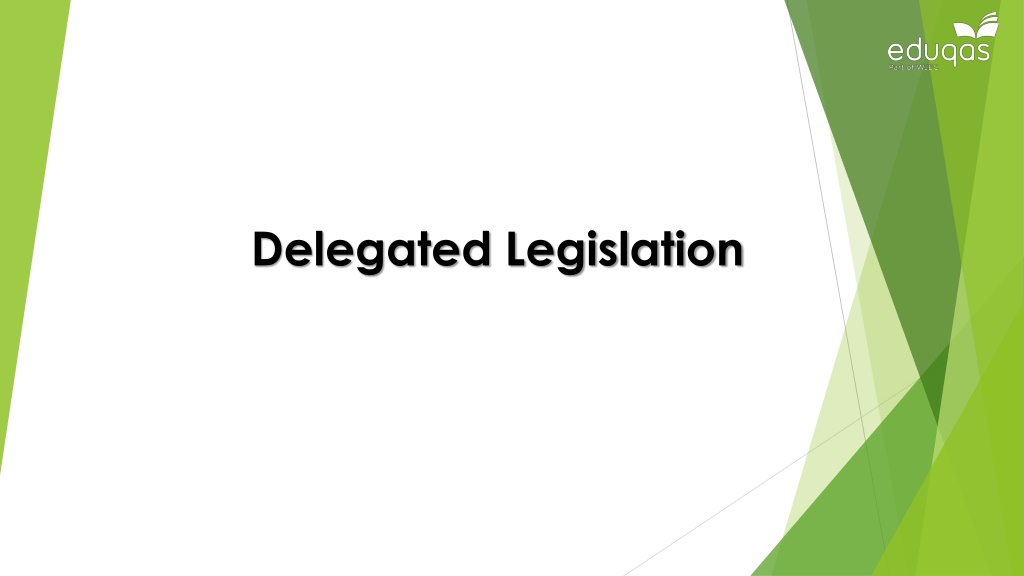
 undefined
undefined






